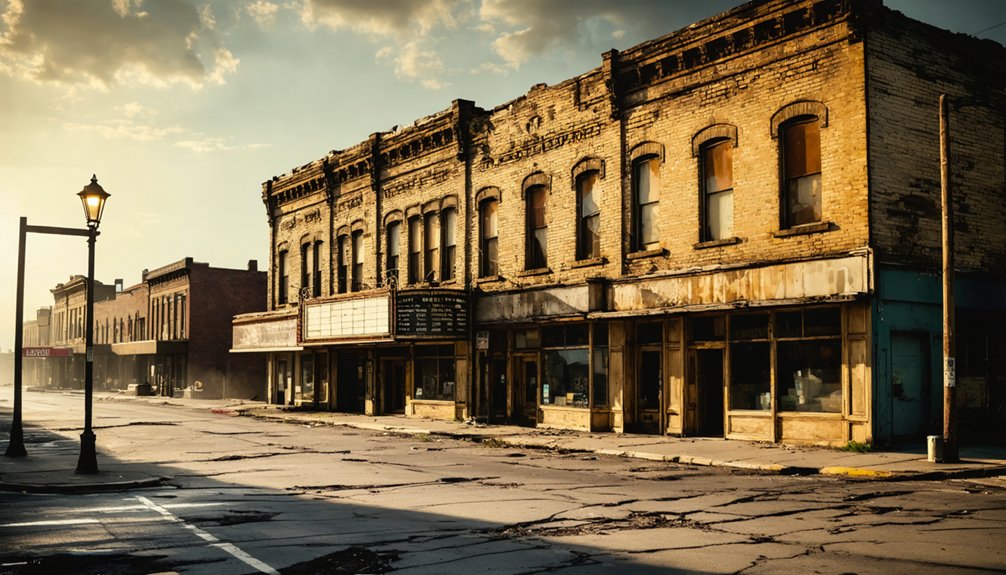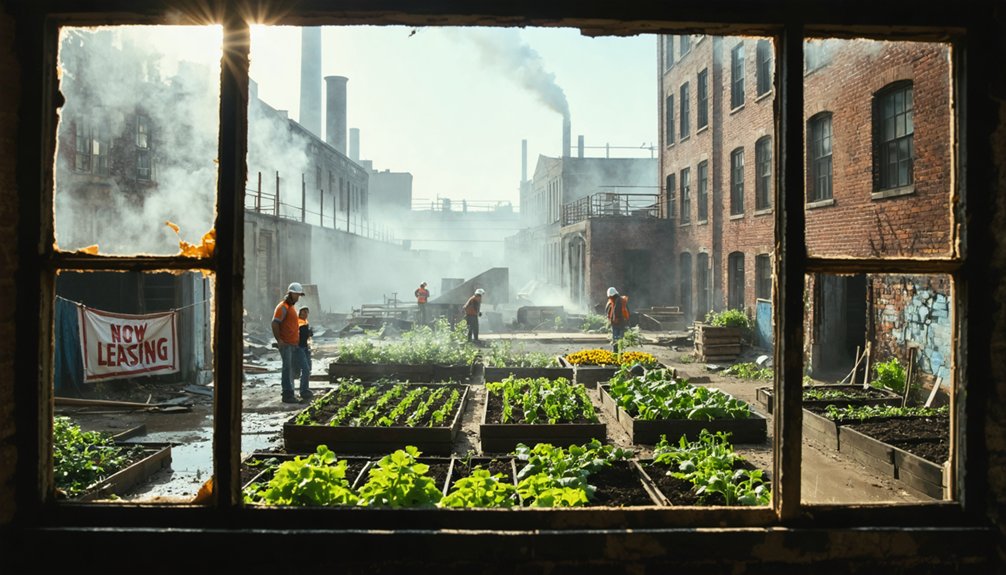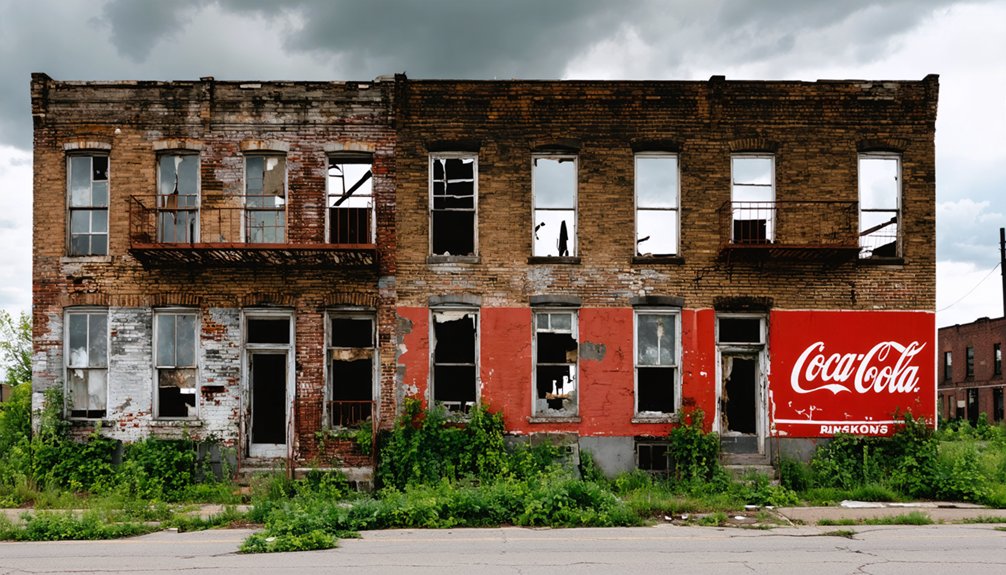You’ll find America’s industrial past beautifully preserved in three standout rust belt ghost towns: Lowell, Michigan, with its frozen-in-time Victorian industrial architecture; Centralia, Pennsylvania, where a 60-year underground mine fire created an eerily abandoned landscape; and McKeesport, Pennsylvania, where National Tube Works remnants showcase steel’s golden age. These forgotten communities offer powerful glimpses into economic transformation, environmental disaster, and the resilient spirit that once defined America’s manufacturing heartland.
Key Takeaways
- Lowell, Michigan preserves Victorian industrial architecture along the Grand River from its 1831 origins as a trading post.
- Centralia, Pennsylvania offers a haunting mid-century American landscape with St. Mary’s Catholic Church standing amid abandoned streets.
- McKeesport, Pennsylvania maintains National Tube Works remnants and architectural treasures through its active Preservation Society.
- These Rust Belt towns showcase frozen-in-time structures that document America’s industrial heritage despite economic decline.
- Preservation efforts in these communities focus on adaptive reuse and maintaining historical architecture as catalysts for community identity.
Lowell, Michigan: Victorian Industrial Legacy Frozen in Time
Three distinct phases define Lowell’s Victorian industrial journey: its humble beginnings as an 1831 trading post established by Daniel Marsac, its northward expansion in 1847, and its transformation into a thriving industrial hub.
You’ll find impressive industrial architecture along the Grand River, where mills and manufacturing facilities once powered the local economy. The Detroit-Milwaukee-Grand Haven railroad’s arrival in 1857-58 accelerated Lowell’s growth as a regional trading center.
Industrial grandeur meets riverfront history where the Grand River’s power and railway connections transformed Lowell’s economic landscape.
Community engagement flourished without formal meeting halls, with residents gathering for fireworks and band performances. Unlike South Boston which had the Grange Hall established in 1874 capable of hosting 400-500 people as a cultural center.
Historical photos from 1885 reveal vibrant commercial streets lined with livery stables and general stores. The closure of these key industries eventually forced residents to leave in search of employment elsewhere.
Following late 20th-century economic shifts, this Rust Belt town experienced significant decline, preserving its Victorian-era structures in a rare, frozen-in-time state that exemplifies industrial heritage.
Centralia, Pennsylvania: The Haunting Beauty of America’s Longest-Burning Ghost Town
While Lowell’s industrial ghost town emerged from economic shifts, Centralia’s haunting landscape was born from a catastrophic environmental disaster that continues to this day. When you visit, you’re witnessing the aftermath of a 1962 trash fire that ignited underground coal seams, creating the infamous Centralia fire that still burns beneath your feet.
Unlike most ghost towns, Centralia was deliberately abandoned as toxic legacy issues—carbon monoxide emissions, ground subsidence, and sinkholes—made life untenable.
You’ll find remnants of a once-thriving community of 3,000 now reduced to fewer than 10 residents. Though the iconic Graffiti Highway is now buried, you can still observe St. Mary’s Catholic Church standing defiantly amid street grids leading nowhere, creating an eerie tableau of mid-century American life frozen in environmental catastrophe. The ground temperature in residential areas once reached 746 degrees, cooking vegetables right in the soil. The mine fire beneath the town is expected to continue burning for another 250 years, making Centralia a unique testament to the long-lasting environmental impacts of coal mining disasters.
McKeesport, Pennsylvania: Steel City Renaissance Through Preservation
McKeesport stands as a tribute to America’s industrial heritage, where the remnants of a once-mighty steel empire now form the foundation for an ambitious preservation movement.
When you visit this former steel powerhouse, you’ll witness the tangible legacy of National Tube Works, which once employed 10,000 workers before merging into U.S. Steel in 1901.
The McKeesport Preservation Society now champions the protection of architectural treasures like the Penn-McKee Hotel, using historic conservation as a catalyst for community heritage and industrial resurgence.
Despite losing 15,000 steel jobs in the 1980s, McKeesport’s identity remains anchored in its immigrant workforce history and manufacturing spirit.
Beyond merely preserving buildings, contemporary revitalization efforts emphasize adaptive reuse and community connection, honoring the resilience of generations who built America’s industrial might while reimagining a post-industrial future. The city’s population has fallen dramatically from its industrial peak to approximately 17,132 residents today. Located at the confluence of rivers, McKeesport’s strategic waterfront position offers significant potential for mixed-use development that could revitalize the former mill town.
Frequently Asked Questions
How Safe Are Ghost Towns for Solo Travelers?
Ghost towns pose significant risks for solo exploration. You’ll need thorough safety precautions: research locations, inform others of plans, wear protective gear, and remain alert to structural and environmental hazards.
Can Visitors Legally Collect Artifacts From Abandoned Buildings?
A collector in Ohio faced felony charges after removing artifacts from an abandoned factory. You can’t legally take items without owner permission—artifact laws prohibit it, and ethical considerations suggest photographing instead of disturbing historical contexts.
What Photography Permits Are Needed in These Locations?
You’ll need permits for commercial photography in most preserved locations. Requirements vary by site ownership—public lands enforce stricter photography regulations, while private locations may require specific permissions from property managers.
Are There Lodging Options Within the Ghost Towns?
No, you won’t find rustic accommodations within these towns themselves. Lodging options are typically available in neighboring communities, not within the abandoned historical lodgings of these preserved sites.
How Do Seasonal Changes Affect Accessibility to These Sites?
You’ll brave apocalyptic winter roads or summer’s tourist hordes—there’s no middle ground! Seasonal weather dramatically affects accessibility, with winter snow blocking pathways, spring flooding causing damage, summer offering ideal conditions, and fall providing scenic but limited exploration time.
References
- https://www.christywanders.com/2024/08/top-ghost-towns-for-history-buffs.html
- https://www.visittheusa.com/experience/5-us-ghost-towns-you-must-see
- https://en.wikipedia.org/wiki/Ghost_town
- https://www.youtube.com/watch?v=q-4LJ9Z0gWc
- https://www.geotab.com/ghost-towns/
- https://noospheregeologic.com/blog/tag/ghost-towns/
- https://www.atlasobscura.com/lists/americas-best-preserved-ghost-towns
- https://en.wikipedia.org/wiki/Wikipedia:WikiProject_Ghost_towns/Assessment
- https://www.lovemoney.com/gallerylist/86648/americas-empty-ghost-towns-and-why-theyre-abandoned-today
- https://www.lowellmuseum.org/ghost-towns.html



